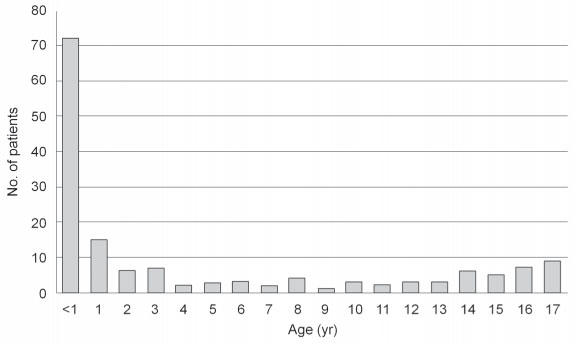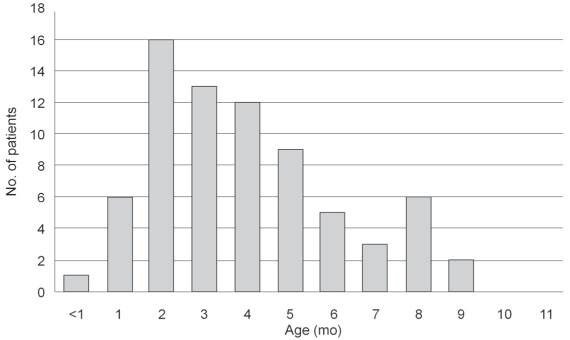Pediatr Allergy Respir Dis.
2012 Jun;22(2):188-196.
Causes and Outcome of Tracheostomy in Children
- Affiliations
-
- 1Department of Pediatrics, Sahmyook Medical Center, Seoul, Korea.
- 2Department of Pediatrics, Gwangmyeong Sungae Hospital, Gwangmyeong, Korea.
- 3Department of Otorhinolaryngology-Head and Neck Surgery, Samsung Medical Center, Sungkyunkwan University School of Medicine, Seoul, Korea.
- 4Department of Pediatrics, Samsung Medical Center, Sungkyunkwan University School of Medicine, Seoul, Korea. kmaped@skku.edu
Abstract
- PURPOSE
Tracheostomy is used to aid airway management in perdiatric respiratory care. This study was designed to review causes and outcomes of pediatric tracheostomy.
METHODS
We performed a retrospective chart review of 153 patients, less than 18 years of age, who underwent tracheostomy between January 1995 and July 2010. Age at tracheostomy, indications, durations, complications and mortality were evaluated.
RESULTS
Subglottic stenosis (19%) was the most common indication for tracheostomy. The median age at tracheostomy was 1.3 years (range, 22 days to 17.8 years). Seventy-three (47.7%) tracheostomies were performed in children under 1 year of age. Respiratory diseases were significantly more prevalent in patients under 1 year of age, while neuromuscular disease were more frequently found in patients older than 1 year (P=0.013). Stoma or tracheal granuloma formation (36.6%) was the most common complication of pediatric tracheostomy. Decannulation was accomplished in 61 (39.9%) patients with median cannulation time of 141 days (range, 1 to 2,529 days). Overall mortality rate was 10.5% (n=16), but only one patient (0.7%) died from tracheostomy-related complications.
CONCLUSION
Respiratory diseases, such as subglottic stenosis and neuromuscular disease, are the main cause of pediatric tracheostomy. Although complications, like stoma or tracheal granuloma formation occur, tracheostomy in children is a safe way to aid airway management.
Keyword
MeSH Terms
Figure
Reference
-
1. Wetmore RF. Bluestone CD, Stool SE, Alper CM, Arjmand EM, Casselbrant ML, Dohar JE, editors. Tracheotomy. Pediatric Otolaryngology. 2003. 4th ed. Philadelphia: Saunders;1583–1598.2. Lewis CW, Carron JD, Perkins JA, Sie KC, Feudtner C. Tracheotomy in pediatric patients: a national perspective. Arch Otolaryngol Head Neck Surg. 2003. 129:523–529.3. Ozmen S, Ozmen OA, Unal OF. Pediatric tracheotomies: a 37-year experience in 282 children. Int J Pediatr Otorhinolaryngol. 2009. 73:959–961.
Article4. Al-Samri M, Mitchell I, Drummond DS, Bjornson C. Tracheostomy in children: a population-based experience over 17 years. Pediatr Pulmonol. 2010. 45:487–493.
Article5. Parrilla C, Scarano E, Guidi ML, Galli J, Paludetti G. Current trends in paediatric tracheostomies. Int J Pediatr Otorhinolaryngol. 2007. 71:1563–1567.
Article6. Mahadevan M, Barber C, Salkeld L, Douglas G, Mills N. Pediatric tracheotomy: 17 year review. Int J Pediatr Otorhinolaryngol. 2007. 71:1829–1835.
Article7. Corbett HJ, Mann KS, Mitra I, Jesudason EC, Losty PD, Clarke RW. Tracheostomy: a 10-year experience from a UK pediatric surgical center. J Pediatr Surg. 2007. 42:1251–1254.8. Tantinikorn W, Alper CM, Bluestone CD, Casselbrant ML. Outcome in pediatric tracheotomy. Am J Otolaryngol. 2003. 24:131–137.
Article9. Midwinter KI, Carrie S, Bull PD. Paediatric tracheostomy: Sheffield experience 1979-1999. J Laryngol Otol. 2002. 116:532–535.
Article10. Watier-Launey C, Buronfosse A, Saliba E, Bertrand P, Ployet MJ. Predictive factors for complications in children with laryngeal damage at extubation. Laryngoscope. 2000. 110(2 Pt 1):328–331.
Article11. Carron JD, Derkay CS, Strope GL, Nosonchuk JE, Darrow DH. Pediatric tracheotomies: changing indications and outcomes. Laryngoscope. 2000. 110:1099–1104.
Article12. Wetmore RF, Handler SD, Potsic WP. Pediatric tracheostomy. Experience during the past decade. Ann Otol Rhinol Laryngol. 1982. 91(6 Pt 1):628–632.13. Chung MH, Kim SH, Jang MS, Lee JH, Han JW, Lee JH. A clinical study of tracheotomy in pediatrics. Korean J Otolaryngol-Head Neck Surg. 1998. 41:1472–1477.14. Kim CH, Lee JW, Oh JH, Choung YH, Park MS. A clinical study of pediatric tracheotomy. Korean J Otolaryngol-Head Neck Surg. 2005. 48:500–505.15. Kim KH, Sung MW, Oh SJ, Jeong HS, Choi BY, Park MH, et al. Complications in pediatric tracheotomy. Korean J Otolaryngol-Head Neck Surg. 2000. 43:1350–1354.16. Itamoto CH, Lima BT, Sato J, Fujita RR. Indications and complications of tracheostomy in children. Braz J Otorhinolaryngol. 2010. 76:326–331.17. Kim MH. Changes in birth rates of low birth weight and premature infants in Korea over the past 7 years. Korean J Pediatr. 2008. 51:233–236.
Article18. Bae CW. The changes in the birth and mortality rates of newborn in Korea. J Korean Med Assoc. 2006. 49:975–982.
Article19. Bae YM, Bae CW. The changes in the mortality rates of low birth weight infant and very low birth weight infant in Korea over the past 40 years. J Korean Med Sci. 2004. 19:27–31.
Article20. Zenk J, Fyrmpas G, Zimmermann T, Koch M, Constantinidis J, Iro H. Tracheostomy in young patients: indications and long-term outcome. Eur Arch Otorhinolaryngol. 2009. 266:705–711.
Article21. Leung R, Berkowitz RG. Decannulation and outcome following pediatric tracheostomy. Ann Otol Rhinol Laryngol. 2005. 114:743–748.
Article22. Yaremchuk K. Regular tracheostomy tube changes to prevent formation of granulation tissue. Laryngoscope. 2003. 113:1–10.
Article23. Koitschev A, Simon C, Blumenstock G, Mach H, Graumuller S. Suprastomal tracheal stenosis after dilational and surgical tracheostomy in critically ill patients. Anaesthesia. 2006. 61:832–837.
Article24. Koitschev A, Graumueller S, Zenner HP, Dommerich S, Simon C. Tracheal stenosis and obliteration above the tracheostoma after percutaneous dilational tracheostomy. Crit Care Med. 2003. 31:1574–1576.
Article25. Raghuraman G, Rajan S, Marzouk JK, Mullhi D, Smith FG. Is tracheal stenosis caused by percutaneous tracheostomy different from that by surgical tracheostomy? Chest. 2005. 127:879–885.
Article26. Ledl C, Mertl-Roetzer M. Tracheal and tracheostomal hypergranulation and related stenosis in long-term cannulated patients: does the tracheostomy procedure make a difference? Ann Otol Rhinol Laryngol. 2009. 118:876–880.
Article27. Blumin JH, Johnston N. Evidence of extraesophageal reflux in idiopathic subglottic stenosis. Laryngoscope. 2011. 121:1266–1273.
Article28. Walner DL, Stern Y, Gerber ME, Rudolph C, Baldwin CY, Cotton RT. Gastroesophageal reflux in patients with subglottic stenosis. Arch Otolaryngol Head Neck Surg. 1998. 124:551–555.
Article29. Hopkins C, Whetstone S, Foster T, Blaney S, Morrison G. The impact of paediatric tracheostomy on both patient and parent. Int J Pediatr Otorhinolaryngol. 2009. 73:15–20.
Article
- Full Text Links
- Actions
-
Cited
- CITED
-
- Close
- Share
- Similar articles
-
- Dysphagia and Decannulation Following Tracheostomy in Children
- Tracheostomy in children: A 9-year experience in a tertiary hospital in Korea
- The Effects of Tracheostomy for the Functional Outcomes of Severe Traumatic Brain Injury Patients
- Tracheoesophageal Fistula Following Prolonged Tracheostomy Cannulation
- Comparison of Nasotracheal Intubation and Tracheostomy in the Management of Upper Airway Obstruction in Children



